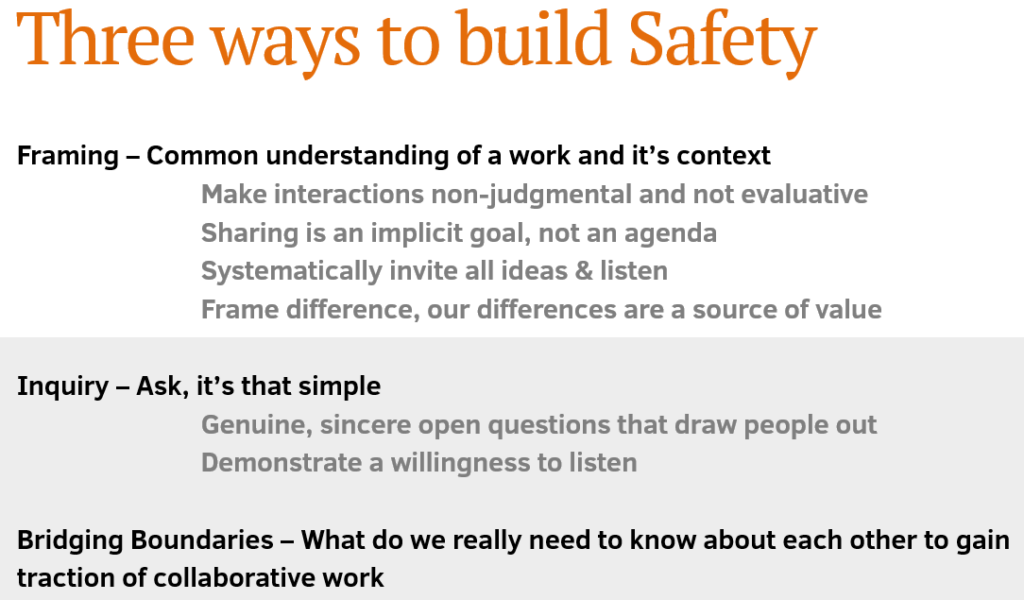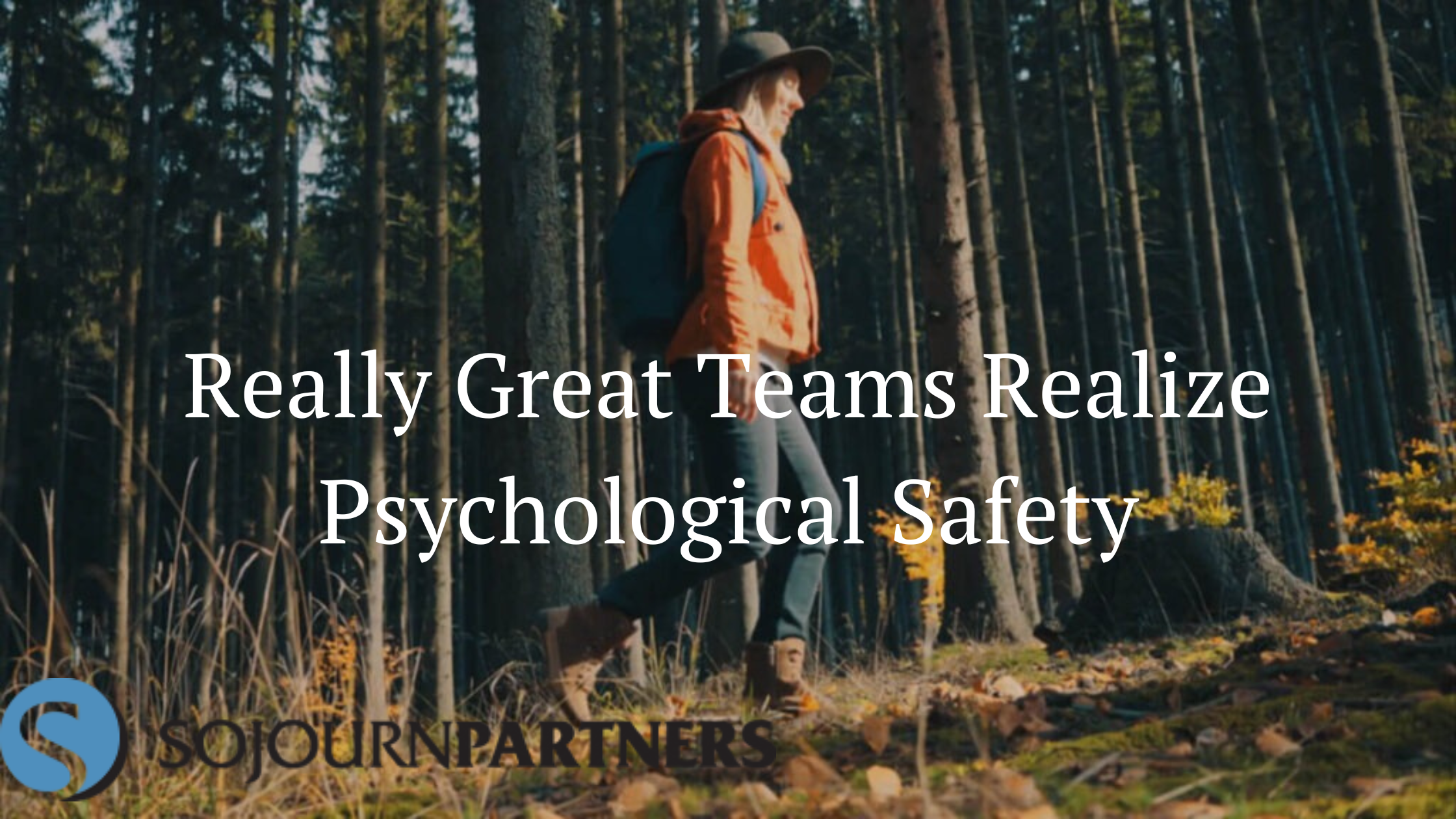Really Great Executive Teams Realize Psychological Safety
For all of us to be at our best as a team and individual contributors, we need to be confident, motivated, and have the ability to be in the arena, as Theodore Roosevelt understood. We need to engage our peers up and down the organizational chart, have the feeling we are free to be ourselves, and provide the value we have. If we are not confident, it could just be that we don’t feel safe. Safe in speaking up, asking important questions, and not feeling judged. If we don’t feel safe, we won’t be confident and be withdrawn from the action.
What is Psychological Safety and How to Build it
The success of any great team is contingent upon their ability to freely share ideas, admit mistakes, and work to find innovative solutions to organizational challenges. Psychological safety can be defined as an environment where a person is free to express themselves without judgement, intimidation, or consequence. Think of a time when you were sitting in the first day of class. You notice that everybody’s very quiet, everybody’s waiting, everybody’s trying to get the landscape to find their voice. This is because psychological safety has not been established until that first brave soul speaks up and everybody sees that it’s okay. Once things get going it’s smooth sailing. It’s the responsibility of the teacher to make sure that ideas are flowing, and it feels safe for people to articulate their ideas. When teams are in this kind of flow, wonderful things start to happen. As a leader, it is imperative that we make our people, and our teams, get the sense that their engagement is valuable, needed, and important.
Smooth Sailing
When times are good everyone is doing their job and the sailing is smooth. Everyone feels safe, secure, and stable. However, there may be an event or challenge that begins to put pressure on the company and its people. In short order, this can lead to dysfunction, infighting, and abdication of responsibility. These are symptoms of an organization who lacks a psychological safety. People go from being productive and safe to coping. Just coping to get through the meeting, situation, or workday.
Where Change Starts
As an executive coach, I can get called in when the sailing starts to get rough. I met with a healthcare organization who, by their own admission, needed help building a team approach. When I met with the executive team, I asked them what type of team do they want to be? I was met with a response that is not unfamiliar, but still striking. One of the executives said to me, “Why do we need to be a team? Let’s just do our jobs; let’s just stay in our own lanes”. Looking around the room, I could see one person was clearly not interested in engaging the rest of the team, three people were clearly just coping and trying to stay off the radar. I concluded that there were some psychological safety challenges. They even admitted that they don’t feel safe. They couldn’t express their ideas or comments without some passive aggressive retorts and there were no relatable relationships in the room. So, how do we create the necessary psychological safety to right the ship?
Building Safety
When we feel the most safe, we have a clear idea of what we are doing and our role in that effort, open inquiry is encouraged, and we have a sense of relationship to the effort and each other.
Recent research suggests safety can be built in three parts:

Three Ways to Build Psychological Safety:
- Framing – Common understanding of a work and it’s context
- Make interactions non-judgmental and not evaluative
- Sharing is an implicit goal, not an agenda
- Systemically invite all ideas & listen
- Frame difference, our differences are a source of value
- Inquiry – Ask, it’s that simple
- Genuine, sincere open questions that draw people out
- Demonstrate a willingness to listen
- Bridging Boundaries – What do we really need to know about each other to traction of collaborative work
As in the classroom example, it is helpful for participants to generally understand the direction and outcome we are seeking. If we don’t understand the syllabus, we will hold back and wait for that clarity. The same is true at work. If we don’t know generally the vision, some targeted outcome, the purpose, then we don’t know where we fit. Where our voices fit.
In the classroom, we know that when we speak up, even with an innovative idea, it is a building block for more discussion. This allows us to be curious, lean in, and offer ideas that the rest of the students can build upon. When we’re leading or facilitating a meeting at work, we have to establish the norm that all ideas are of value. As the facilitator, we need to be open to what those ideas are even if they seem offbeat or overly innovative. We must lead meetings with an open mind with the hopes of finding the right answer, not necessarily our answer. When participants know this, they start to dig in and vector in on a better answer to solve a problem. Better than we would individually. This practice is also viral. When the facilitator sets the norm of all ideas have value, others will join the conversation who may have previously sat on the sidelines.
Finally, just as with any other productive team activity, it’s important that we have some sense of relationship, care, and respect for the people we’re engaging with. I’m not suggesting that we need to have deep thriving relationships, but we do need to acknowledge and understand the value of each contribution, experience, and approach. This can be accomplished by ensuring that everybody speaks up and feels safe in that pursuit. As we converse and solve the problem, we’ll gain a mutual respect and understanding for each contribution. When facilitating these meetings, it is imperative that everybody be heard, and never be minimized or silenced. Create the norm that it is safe and productive when all contribute.
Diversity Brings Safety
One of the most important aspects of creating psychological safety for a team is diversity. Diversity in the sense of safety is not strictly about gender, race, religion, or any other personal characteristic. Diversity in this sense is diversity of position, title, and rank – whether internal or external to the organization. For example, if you put a bunch of lawyers in a room to solve a problem, they are going to solve it, but its probably not going to be the best solution. However, if you have a lawyer, a banker, a consultant, and an executive from diverse backgrounds in the room you are more likely to have richer ideas and more collaboration. Whether diversity of personal characteristics or industry, there is less of a chance of the group drinking their own Kool-Aid. A diverse team is less likely to bask in their own established ideas. Individuals on a diverse team are more likely to be respectful, self-regulate, and creative.
What else?
You might be thinking, “this is good but who has the time to hear every idea”. Not every problem needs to be solved this way, but critical problems do. We could even argue that brief solutions between you and your employee might also include a few moments of reflecting on their ideas and making sure that they feel they were heard.
Another common pushback to these ideas might be, “we don’t need to hear from everybody because we know the answer”. It is my fundamental belief that reasonable people will come to a reasonable conclusion. When people feel safe and can articulate themselves in a way that’s heard, towards the purpose you have already established, you might also not only get a better idea but get to the solution quicker. If you don’t need other people’s ideas, then what’s their purpose after all.
Remember, psychological safety is a feeling a person has where they can freely express themselves without judgement, intimidation, or consequence. As leaders, we create this environment by providing support, guidance, and openness. If a team member doesn’t feel psychologically safe, they are less likely to admit mistakes, offer innovative solutions, or contribute to the group. If you recognize any of these symptoms with your team, Sojourn Partners is here to help get you and your team back on track.

